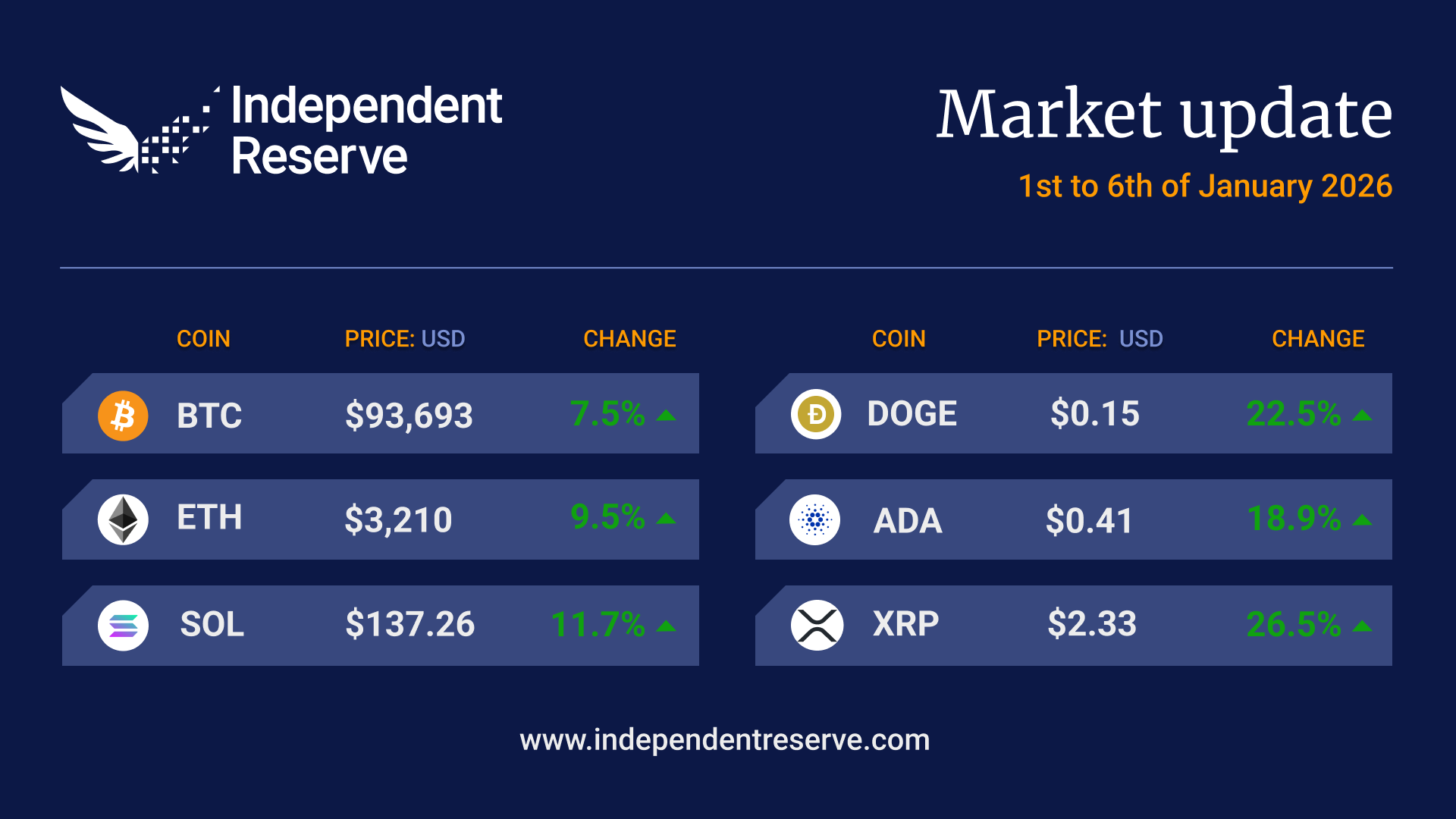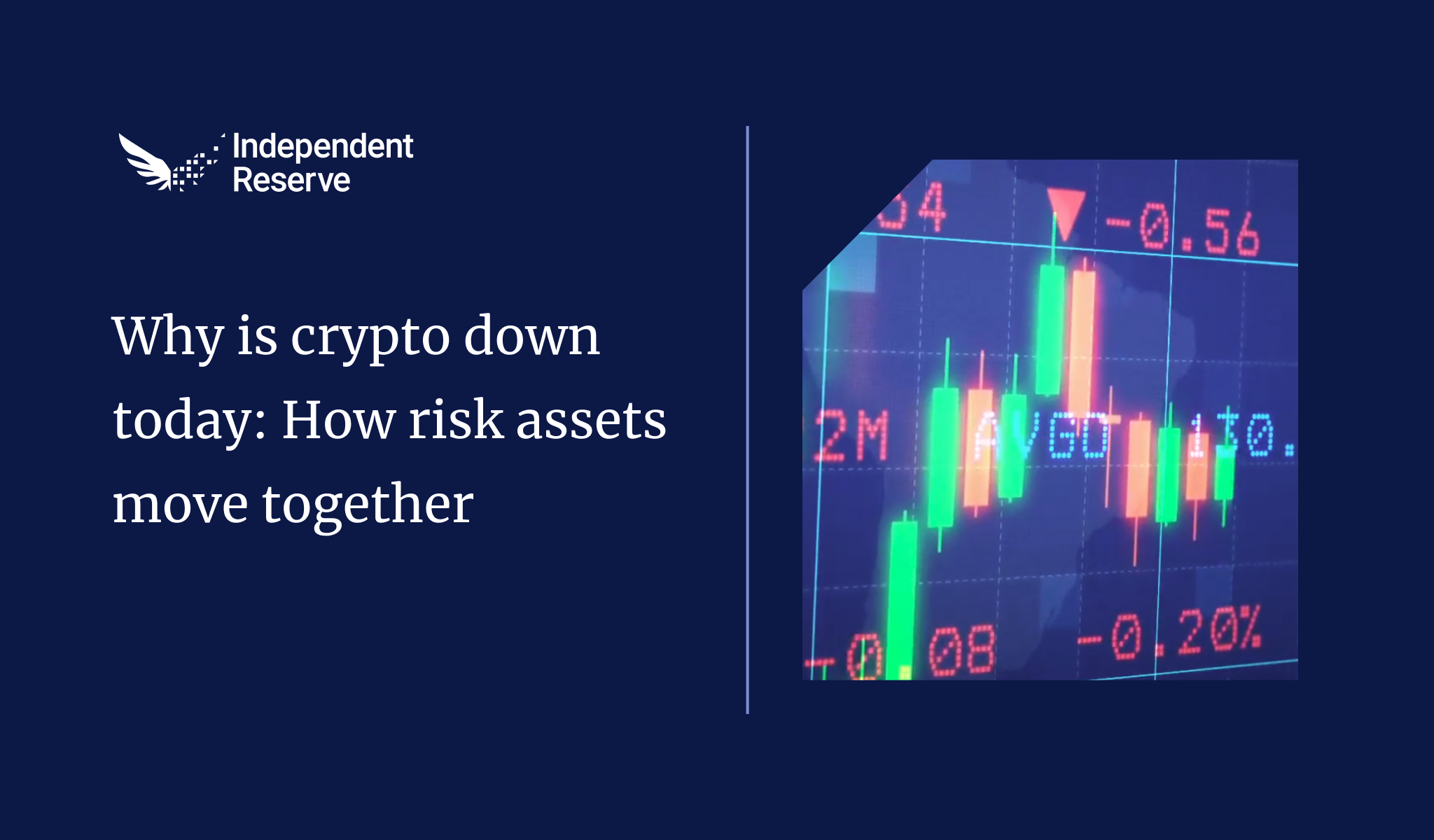In markets
Amid the great crypto crackdown in the US, Bitcoin spiked above US$25K (A$36.2K) this week. Various theories have been advanced about why the price is up when the news is bad: They include the return of the ‘China narrative’ as Hong Kong warms up to crypto, improving macro conditions, an influx of money from big funds , and a hypothesis that users who are unable to redeem Binance-issued BUSD for dollars (after it was declared a security by the SEC) have been dumping it into Bitcoin and Ether. At the time of writing, Bitcoin had recorded a 14.4% gain on a week ago to trade at A$35,810 (US$24.8K), while Ether was up 13.8% to A$2,455 (US$1,700). Everything else was up, including Ripple (6.9%), Cardano (12.5%), Polygon (24.6%) and Dogecoin (7.1%). The Crypto Fear and Greed Index is at 58 or Greed.

From the OTC Desk
This week has seen broad outperformance from cryptocurrencies as an asset class (particularly Layer 1 tokens). The rally appears to have been led by a sharp unravelling of short positions in speculative US tech stocks like Silvergate Capital, Carvana and Coinbase et al. There is also a theory that outflows of BUSD have been allocated into the majors, as well as USDT, helping to support pricing. BTC has traded independently of moves in precious metals and global equities – something we haven’t seen for quite some time. This was despite the continuation of regulatory headlines specifically focused on stablecoins and staking. Importantly for cryptocurrencies, jurisdictional (regulatory) clarity is beginning to take place, albeit in the initial stages, with Hong Kong and the UAE leading the way. With price movements this week being agnostic to the macroeconomic landscape, only time will confirm whether cryptocurrencies can continue to forge their own, market-leading, price path from here.
Last week, the critical economic data was the US CPI. Remaining somewhat ‘sticky’, the Inflation Rate YoY (Jan) printed at 6.4% versus a market forecast of 6.2%. Core inflation also remained elevated at 5.6% against an expected forecast of 5.5%. Positively, US retail sales (Jan) increased by 3%, highlighting that the US consumer remains incredibly solid. This week, Thursday delivers the Federal Open Market Committee (FOMC) minutes; Friday sees US Q4 GDP; and Saturday morning (AEDT) highlights the all-important PCE inflation rate (the FOMC’s preferred measure for inflation). Expect trading into the ‘NY close’ to be volatile.
In Australia, the terminal cash rate is forecast to reach near 4.3% in Q3 2023, highlighting a dramatic shift in market expectations – previously at 3.7% before the February Reserve Bank of Australia (RBA) meeting! Important to this forecast will be this week’s AU Wage Price Index data. Wage inflation remains one of the key components of core inflation. Scheduled for Wednesday at 11:30 am (AEST), the Q4 AU Wage Price Index (YoY) is expected to print at 3.5% against a prior Q3 reading of 3.1%. Watch this space.
On the OTC desk, managing BUSD flow has proven to be difficult this week, with pricing remaining volatile. Historically, we have always highlighted ETH/BTC as being a leading indicator for Alts. Like other pricing correlations this week, this too has broken down. With ETH/BTC down 0.86% on the week to currently trade at 0.0685. Meanwhile, layer 1 tokens like SOL, NEAR, AVAX and Algo have all outperformed.
For any further information, please feel free to reach out.
Bad trading
Research from the Bank for International Settlements suggests the average retail trader who bought Bitcoin after 2015 lost money. If true, that’s astonishing given Bitcoin was worth just A$450 that year, but BIS attributes it to the propensity of retail traders to buy high and sell low, while institutions and whales do the exact opposite. “Data on major crypto trading platforms over August 2015 – December 2022 show that, as a result, a majority of crypto app users in nearly all economies made losses on their Bitcoin holdings,” the report says.
Bull trap?
According to a CryptoQuant analyst the 30-day moving average for active Bitcoin addresses has barely budged during this latest rally. The indicator spiked during the 2019 rally and the recovery from the March 2020 crash, suggesting an influx of new users and activity. But lower values could indicate that general trading interest is low. “The ‘price’ of an asset is determined by the laws of supply and demand in the market. Crypto markets are no exception,” explained the analyst. “For asset prices to rise, market interest and demand must be supported.”
Hong Kong warms up
The China narrative returned this week, with US$100B (A$145B) flowing back into markets amid rumours that Hong Kong was opening up to retail trading from June 1. The rumours were quickly ‘debunked ’ as only accredited investors will be able to trade under its new licensing regime for Virtual Asset Service Providers (crypto exchanges) that goes into effect on that date. However The Block reported today Hong Kong regulators are opening up consultation on allowing retail traders back in. Huobi Global is now seeking a licence in the territory.
SEC to ‘block access to crypto’
The SEC has proposed changes to the 2009 custody rules so that almost any assets that an adviser might hold in a client’s name, including crypto, must meet the qualified custodian requirements. In theory, this could mean every crypto exchange would need to become qualified custodians (some, like Coinbase, insist they already are). However, the SEC noted that due to crypto’s unique attributes, it may be difficult to actually comply with the rules. SEC Commissioner Mark T. Uyeda said, “This approach to custody appears to mask a policy decision to block access to crypto as an asset class.” He appears to be referring to institutions rather than retail, but it would be a sweeping change. The proposals are out for comment now.
Terraform Labs charges
Singapore-based Terraform Labs and its founder, Do Kown, have been charged by the SEC with “orchestrating a multi-billion-dollar crypto asset securities fraud involving an algorithmic stablecoin and other crypto asset securities.” In a 55-page complaint, the SEC said Terraform “touted and marketed” Anchor Protocol, which advertised up to 20% APY, and alleged it misled investors about how stable the UST stablecoin was. The SEC characterised UST, Luna, wLuna, and MIR as securities, which worries onlookers that it considers everything to now be a security . Blockchain Association lawyer Jake Chervinsky says that’s precisely the SEC’s view , but says the BA will fight them in court if they overstep the law and pointed out the regulators are ultimately subservient to legislation when it finally gets passed.
Crypto Singapore’s top fintech investment
Crypto and blockchain was the top area for fintech investment in Singapore in 2022 according to the KPMG Pulse of Fintech report . That’s despite a “particularly noticeable” decline in the second half of the year following various industry implosions. In Singapore, crypto-related funding fell from US$1.5 billion (A$2.17B) in 2021 to US$1.2 billion (A$1.74B) in 2022 while worldwide investments fell from US$30 billion (A$43.5B) in 2021 to US$23.1 billion (A$33.4B) in 2022.
Bits and pieces
The largest and longest running Ethereum event Eth Denver is being held from February 24 to March 5, with rumoured announcements about decentralising Infura and updates on the account abstraction EIP. The adoption of Ordinals (Bitcoin NFTs) has also seen the average Bitcoin block size spike above 2MB in the past week which Glassnode CTO Rafael Schultze-Kraft says is the first significant increase since the 1MB cap was removed with Segwit in August 2017. YouTube’s newly appointed CEO Neil Mohan is a crypto fan and spoke last year about the ” incredible potential ” for YouTube to integrate Web3 tech. Amid the regulatory drama, Binance is reportedly reviewing its investments in the US. Almost one in four new crypto tokens in 2022 resembled pump and dump scams according to Chainalysis. Crypto scam revenue declined from US$10.9B (A$15.8B) in 2021 to just US$5.9B (A$8.55B) in 2022 , however that pretty much just mirrored crypto price declines. Veteran trader Peter Brandt has spotted a ‘price wall’ pattern on the Bitcoin chart that “typically represent MAJOR turning points ” while billionaire Mike Novogratz says there’s a good chance of Bitcoin breaching US $30K (A$43.5K) by the end of March .
Until next week, happy trading!


